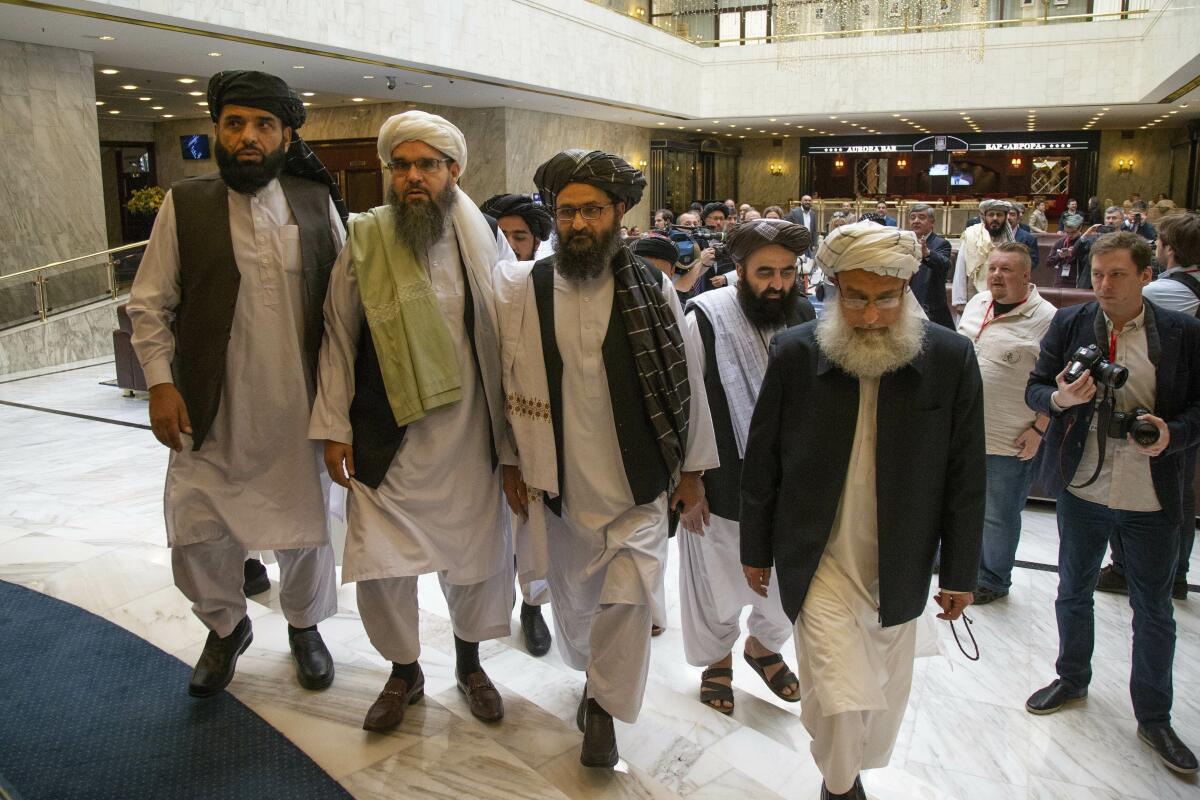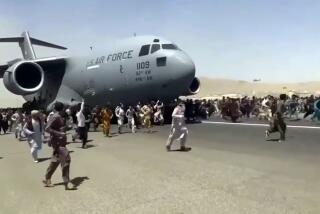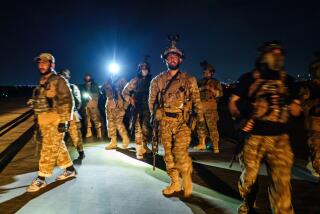Trump gambles on plan to bring home some U.S. troops from Afghanistan before election

- Share via
WASHINGTON — President Trump has a lot riding on a precarious agreement with Taliban militants to end America’s longest war. But the process, which began over the weekend, is fraught with obstacles that could lengthen the conflict rather than conclude it.
The first step in the deal agreed to by the U.S. and the Taliban is a seven-day period of “reduced violence” in which neither side attacks. The period began Saturday and includes a moratorium on the roadside explosive devices, rockets and suicide bombers that have been the Taliban trademark and continued as recently as last month.
It falls short of a cease-fire, which the Taliban consistently refused to consider. But if the weeklong pause is declared a success, U.S. and Taliban leaders will sign a deal in Doha, Qatar, on Feb. 29 that begins the drawdown of American troops in exchange for Taliban vows to fight terrorism and stop attacks against the United States.
“This [reduction in violence phase] will serve as a test period of Taliban intent and control of their forces, and as a proof of concept of their commitment to the peace process,” senior State Department official Molly Phee said last week.
“It has taken a lot of work, frankly, to get to this point. But we believe we have established the conditions that can transform the trajectory of the conflict,” she added. “It is high time for the parties to begin moving off the battlefield and into a political process.”
Phee is deputy to Zalmay Khalilzad, the administration’s special representative for Afghanistan who has led more than a year of negotiations with a Taliban team that includes men once jailed in the U.S. military prison at Guantanamo Bay, Cuba.
As of Thursday, Taliban attacks and U.S. airstrikes had fallen off significantly and the truce was largely holding, U.S. officials said.
.
But numerous obstacles will complicate the next phase, which includes bringing the Afghan government into talks with the Taliban and other domestic organizations. The government has been kept out of negotiations until now, in part because Taliban leaders don’t recognize it.
Some critics worry that in a rush to secure an election-year troop withdrawal, Trump might agree to terms that fail to protect U.S. counterterrorism operations or hard-fought civil rights in Afghanistan. Others say conditions for withdrawing U.S. troops are as good now as they ever will be.
“This is a long shot under the best of circumstances,” said Bruce Riedel, a veteran CIA officer who specialized in the region and advised Democratic and Republican White Houses. “Trump badly wants to claim a victory.”
But Riedel said one hard part will be working directly with the Taliban without undercutting the Afghan government, which Washington has backed throughout the nearly two decades of U.S. intervention launched after the Sept. 11, 2001, terrorist attacks. “We are stuck in a war with no easy way out without leaving one side in the lurch,” he said.
Complicating matters even more, the Trump administration now finds itself in the odd position of entering into important deals with the Taliban without a clear partner in the Afghan government.
Official presidential election results announced last week — nearly five months after the vote — gave the victory to incumbent President Ashraf Ghani. But his chief rival, Abdullah Abdullah, has refused to recognize that outcome and declared himself the victor. Within days, the opposing camps deployed their own security forces in an increasingly tense Kabul, and regional warlords were choosing sides.
When asked about the election results, Pompeo declined to endorse Ghani.
Negotiating with the Taliban presents its own challenges. Like the rest of Afghan society, the sprawling group is riven by tribal and regional rivalries. And it has killed hundreds of Americans.
It remains to be seen what happens if attacks against Americans resume after the seven-day pause. Officials say they will deal with such attacks on a case-by-case basis. But Trump has said killing Americans is a red line. He hastily backed out of a deal with the Taliban last fall after it launched an attack that killed a U.S. soldier.
The agreement to be signed Feb. 29 calls for an initial U.S. troop withdrawal over a five-month period. The top U.S. commander in Afghanistan, Gen. Austin “Scotty” Miller, has told Pentagon officials he can safely reduce the U.S. troop level from the roughly 12,000 service members now there to 8,600.
Pentagon officials have insisted that even the first round of withdrawals will be conditioned on Taliban leaders not permitting Al Qaeda and other terrorist groups on Afghan territory.
Other officials have also pressed for limiting troop withdrawals unless violence levels remain low and Taliban leaders follow through on promises to hold planned power-sharing talks with Afghan government negotiators.
Whether the U.S. insists on those conditions before making steep troop reductions will depend to a large degree on Trump, said a senior U.S. Defense official who did not want to be quoted speaking about the internal deliberations.
Critics fear that as his reelection campaign moves into full swing this summer, Trump may order troop withdrawals whether or not the looming Afghan peace talks go smoothly, in order to be seen as delivering on his promise to end an era of lengthy U.S. overseas wars.
Trump “wants to bring the force levels down. He’s made that clear. The question is whether he is willing to do it if things start to fall apart. And they usually do in Afghanistan,” a senior Defense official said.
The Pentagon plans to continue its training of Afghan army and police, even as it sharply cuts overall force levels. “A big part” of the remaining U.S. force will be focused on that training, said another U.S. Defense official, who was not authorized to speak publicly.
Miller has also developed options for continuing military operations against Al Qaeda, Islamic State and other terrorist groups, using forces stationed in the region but outside Afghanistan, if necessary.
As long as the Afghan peace talks remain on track, Pentagon officials believe counterterrorism operations can be carried out with relatively small numbers of special operations troops and airstrikes.
Douglas Lute, a retired U.S. Army general who coordinated fighting in Afghanistan late in the George W. Bush administration and under President Obama, said improved U.S. intelligence in the region and a diminished Al Qaeda threat bode well for security.
“We have intelligence access that we didn’t have before,” Lute said. “We’re much better than we were back when we were simply launching cruise missiles into the desert.”
U.S. officials have also pressed NATO members and other countries with troops in Afghanistan not to exit too hastily. There are roughly 8,000 non-U.S. foreign troops there now, and a quick exit of many of them would force steeper cutbacks in critical training programs.
It is unclear whether the agreement will include a timetable or explicit language committing Washington to a complete pullout of its troops. But it’s unlikely the Taliban would sign on to a deal that does not at least theoretically hold that out as the goal, said Laurel Miller, the former acting special representative for Afghanistan and Pakistan at the State Department.
“You have to look at the U.S.-Taliban agreement as the easy part of the deal,” she said. “It’s a viable first step. Whether that first step leads to further steps is still an open question.”
She said the likely message that the administration is sending the Afghan government is: We’re leaving, so you better make the best deal you can. And if you do, we will support you with aid.
However, she added, “If the U.S. withdraws its troops, I’m deeply skeptical that the U.S. Congress is going to continue to send billions of dollars a year to prop up the Afghan government.”
Congress has appropriated nearly $137 billion in aid for Afghanistan since 2002, with about 63% earmarked for security forces and 26% for development projects, according to a report last month by the Congressional Research Service. In 2020, the White House is seeking $4.8 billion in military assistance and $400 million in economic aid.
Another wild card is Pakistan, which has backed the Taliban and benefited from the unrest in its neighbor. Although Pompeo has invested considerable time courting senior Pakistani officials, Islamabad’s support for peace talks is unclear.
Michèle Flournoy, a former undersecretary for Defense, said that while she is concerned Trump might “lose patience and pull the plug,” she believed chances for a broad agreement were the best they have been “across three administrations.”
“While we have been fighting this for 20 years, the Afghans have been fighting this for 40,” she said, referring to the civil war and Soviet intervention that predated U.S. involvement. “So there is a degree of exhaustion on both sides and a degree of stalemate.”
More to Read
Get the L.A. Times Politics newsletter
Deeply reported insights into legislation, politics and policy from Sacramento, Washington and beyond. In your inbox three times per week.
You may occasionally receive promotional content from the Los Angeles Times.












